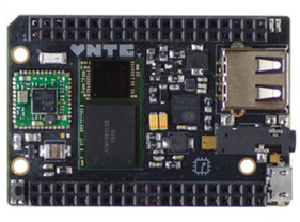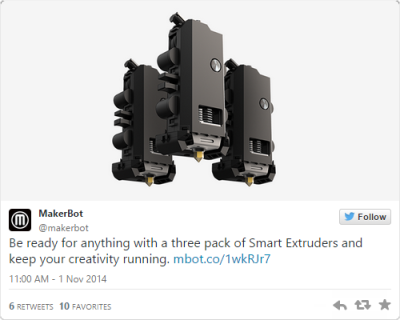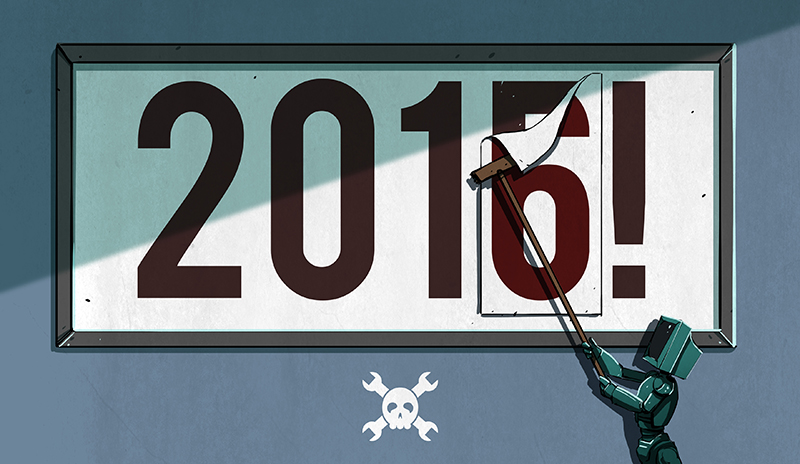A few hours from now, the ball will drop in Times Square. 2015 is over, and the good news is you can easily turn a handwritten ‘5’ into a ‘6’. Keep that in mind for the next few weeks. It’s time for a retrospective of everything that happened in 2015. That’s rather boring, though, and it’s usually better to put the most outrageous items in the lede. Therefore, it’s time for predictions of what will happen over the next 366 days. They are, in order:
- 2016 will be the year of the Linux desktop
- Self-driving cars will be demonstrated
- Graphene! Something to do with graphene!
- Your company will receive a resume with ‘Bitcoin’ listed as a skill
- Fusion power is only nine years away
With that said, a lot happened this year. Tiny Linux single board computers became incredibly cheap, Radio Shack died, and Arduino went crazy.
The Nine, Eight, and Five Dollar Computer

If 2014 was the year of a million single board Linux computers, 2015 was the year of the insanely cheap single board Linux computer. This trend began with C.H.I.P., a Kickstarter that raised $2M of their original $50k goal. The idea is simple enough: sell a computer for $9, and people will fall over themselves reaching for their wallets. Money will be thrown at screens. It really didn’t matter that an adapter board was needed for VGA or HDMI. It didn’t matter these computers wouldn’t be available for six months. It was cheap, low margins high volume buy buy buy.
Right about the time C.H.I.P. was getting ready to ship their nine dollar computers out to backers, the $5 Raspberry Pi Zero was released. It was available in Microcenters and online retailers the very same day. A brilliant coup by the Raspberry Pi Foundation. C.H.I.P. is now an eight dollar computer, and comes with WiFi and Bluetooth, where the Pi requires a few USB adapters. The C.H.I.P. needs an adapter for video output, whereas the Pi Zero comes with HDMI stock. They’re different boards for different uses, but one thing remains constant: there is more and more competition for tiny, cheap single board computers and that can only benefit the consumer.
The Arduino Hullabaloo
2015 will go down as the most important year in the history of Arduino. There’s really no question about that. The funny thing is, the importance of 2015 for Arduino isn’t about any significant boards that were released, and it wasn’t about any new technology. It’s all about trademarks, the two Arduinos, and a bitter rivalry.

It all began in 2009 when Arduino LLC was founded by five guys. Arduino LLC took care of the trademarks, designs, software, community, and everything else that propelled Arduino into the stratosphere. Manufacturing the actual Arduino boards was handled by Smart Projects SRL (the Italian version of an LLC), headed up by one of the original Arduino founders, [Gianluca Martino]. A little more than a year ago, Smart Projects SRL changed their name to Arduino SRL, and last February, Arduino LLC sued Arduino SRL. It only got more confusing from there.
For most of 2015, there were effectively two Arduinos, with SRL telling distributors they were the real Arduino. LLC countered by adding a warning about non-licensed boards in the IDE, and SRL got around that by simply bumping up the minor version number of the IDE.
Things got even more confusing when LLC rebranded themselves as ‘Genuino’ everywhere in the world except for the US. Everybody is playing some very shady games and generally acting like children. That’s not to say these actions aren’t understandable; the Arduino trademark is by far the most valuable asset to both Arduinos.
When will it end? Not soon, that’s for certain. The dispute will be resolved in US Federal court, and the expected outcome is that Arduino LLC will retain the use of the Arduino trademark in the US, and SRL will be able to use the trademark everywhere except the US. It’s a story of betrayal and popcorn, and certainly something to watch in 2016.
Cash Rules Everything Around Me (dolla’ dolla’ bills y’all)
2015 was the year companies had money to spend. A lot of money. The semiconductor industry was shaken up by a lot of mergers and acquisitions. Need a list?
- Dialog might buy Atmel for $4.6 Billion
- NXP and Freescale merged, creating a company worth $40 Billion
- Intel bought Altera for $16.7 Billion
- Avago bought Broadcom for $37 Billion, the largest semiconductor deal ever
- On Semi acquired Fairchild for $2.4 Billion
- Microchip acquired Micrel
- Lattice acquired Silicon Image
- There are continuing rumors TI might buy Maxim
- Western Digital bought SanDisk for $19 Billion
- For the ChemEs, Dow and DuPont merged, creating a company with a market cap of $130 Billion
How did all this happen? Companies were sitting on piles of cash, interest rates were low, and this sort of thing happens every decade or so anyway. What’s going to happen in 2016? Well, interest rates will probably go up, but the semiconductor industry still has plenty of companies in play.
Drones!
In 2012, Congress told the FAA to get off their butts and create some rules for drones, quadcopters, and unmanned aerial systems. The FAA was required – by law – to do this by September 30, 2015. When November rolled around, the FAA realized they hadn’t done what they were supposed to and whipped up some rules in under a month. The rules don’t make any sense, and the Academy of Model Aeronautics is telling members not to register themselves in the FAA’s system. How will this turn out? The AMA currently has a case in federal court, but that’s not going to happen until after New Years. Either way, you don’t have to register yourself as a drone pilot for a few weeks.
3D Printing is so 2014…

Makerbot is dead. I actually know this, but it’ll take me until late March to put the ‘Makerbot is dead’ post together. They’ve cut 36% of their staff, there’s a class action suit (only for investors), and over one year Stratasys stock has gone from over $80 to below $30/share. We await their eventual demise with pleasure.
Other than Makerbot’s upcoming demise, there isn’t actually that much in the 3D printing world to say. Strange metal and plastic-based filaments are all the rage, and very interesting: they allow you to print in something that has the weight and feel of copper, bronze, and iron. A mainstream CoreXY 3D printer still does not exist, but (other than Makerbot), business is booming. 2015 was the year of the trough of disillusionment for 3D printing, and we look forward to the advances that will come in 2016.
Car Hacking
Until 2015, all car hacks focused entirely on the in-vehicle network. The CAN bus in a car controls nearly everything, but until this year, there wasn’t a way to turn any car into an Internet-connected remote control car. This was because of an ‘airgap’ between OnStar, uConnect, and other telematic services offered in most new cars.

This airgap didn’t really exist, as was demonstrated in a paper from [Charlie Miller] and [Chris Valasek]. By bridging this airgap between the WiFi and CAN bus in a Jeep Cherokee. One thing leads to another, and a writer for Wired is seconds away from committing vehicular manslaughter.
There was something strange after [Miller] and [Valasek] published their paper. While we would normally expect a public outcry over evil ‘hackers’ trying to kill people, congressional hearings on the matter, and pundits screaming from the belltowers that something must be done, instead something remarkable happened: nothing. Now no one is trying to protect you from hackers taking over your car. There’s a DMCA exemption for hacking your own car, and congress and the media are relying on the auto industry to make everything secure. This is unprecedented.
How did the auto industry pull this one off? How was the issue of ‘evil hackers’ taking over cars brushed off the table in the minds of an extremely reactionary and not very technically adept media? Cars are driving themselves now. No mind can contain the cognitive dissonance of the hero worship of [Elon Musk] and the idea of remote attacks on poorly designed in-vehicle systems, so everyone is just going with it. 2015 is the year we accepted remote attacks on cars, because cars driving themselves is just too cool. On the other hand, cheating on your emissions testing will put a car company on pretty shaky ground.
Other Newsey Items and The Events of 2015
This has been a big year for silicon. The first 5nm chips are on their way, meaning we’ll probably get a laptop with a 5nm CPU sometime between 2020 and 2025. The first memristor-based products are now available, although we really don’t know what we’re going to do with them. The usefulness of a newborn baby, or something like that.
Radio Shack died. We’ve all been waiting a decade for that news, but Radio Shack is now either officially dead or lingering on in the form of Sprint cell phone stores.
Heathkit is back. 2015 is the year Radio Shack died and Heathkit returned from the dead. Wrap your head around that one. Rumors of Heathkit’s return have been circulating for a few years now, and just a few months ago, they shipped their first product in a decade: an AM radio kit
Hackaday’s parent company bought Tindie and now I can’t un-see the cyberman in the face of the Tindie dog logo. Hackaday.io is booming.
What does 2016 have in store for Hackaday? More everything. More and better content, videos, events, and contests for one of the best communities on the Intertubes. There’s some big changes coming, and they’re all awesome.

















+1 for Wu-Tang reference.
I’ll second the “hackaday.io is booming” comment and add that if you’re reading this and you aren’t a part of the hackaday.io community, you really should re-evaluate your existence.
What do I get for posting the things I’m working on on hackaday.io again? I might try it again. I didn’t do well in the contests (I blame work) but meh.
an easy platform to colaborate with like-minded hackers. Im still not sure how I feel about it compared to a good tech forum (like the eevblog florum), but it is definitely a lot easier to document your project and solicit help from other users with relevant experience.
2016 will be the year of the linux desktop for sure though!
With Win10 sucking so hard, maybe it is!
PC Desktops are almost a niche now anyway. 99% of people are media consumers. Producers (ie engineers, makers, etc) need multiple screens and proper input devices like trackballs and physical keyboards.
Linux does nicely multiple screen, inputs or other custom things. Shame on commercial software not supporting linux
Shame on “Linux” not supporting commercial software.
The drivers interfaces, especially in graphics and sound are still an obsolete mess, and the whole software distribution and indeed OS distribution model is based on a balkanization of “repositories” that ensures no two computer are quite the same or exactly binary compatible with each other, making it an absolute pain in the ass to sell and distribute ordinary consumer level hardware or software that simply works ™ like it does on Apple or Windows.
Most companies run RedHat as their server platform so using that for desktop is consistant and makes sense.
Further than that, OpenOffice runs on every distribution I have every tried to run it on and hardware support is FAR better than on any other platform. Hope you are not an industry leader….
I believe your expectations are backwards. Apple and Microsoft do not go out to insure their OS work with every piecec of software and hardware. Those vendors insure there product work with the Apple and MS OS’. Microsoft say boo many vendors may choose not to support Linux in case Microsoft would deny them the info to support Windows. Windows is the cash cow for the vendors not Linux. I agree FOSS is it’s worst enemy commercially, when it forces it’s customers to review so many options to find the on that works best for them
“Apple and Microsoft do not go out to insure their OS work with every piecec of software and hardware.”
Well, Apple doesn’t, but Microsoft goes a long way to provide a relatively stable environment to the point that the same software package from 1999 still runs the same in 2016 despite having half a dozen OS versions in between.
The differences between versions of Linux distros mere months apart are great enough that you need to re-package virtually everything or else it fails to work, not to mention the differences between the distros themselves, which makes commercial software distribution on Linux an exercise in futility.
“Most companies run RedHat as their server platform so using that for desktop is consistant and makes sense.”
Not really. It’s just the same old red herring about how supercomputers run Linux so it should work for your personal desktop as well. It doesn’t, because the enterprise environment is totally different from the home desktop environment.
Of course you can run your desktop as if your home was a corporate office.
Agreed. I love the Linux desktop but I do agree that if you need commercial software it really sucks!
The days when different distros stored things in different places are pretty much in the past. Also if you support .deb packages you probably support 80% of the users and supporting .rpm too gets you up into the high 90%s.
But… libraries just do not stay binary compatible for more than a week. I would not want to think about all the targets one would need to build for to really market a closed source software package to even 90% of the Linux community. And.. Linux software that I have bought in the past in binary form… pretty much useless today.
I don’t know what would be lost by fixing that. Are glib and all those others significantly better today because their authors have not been bound to maintaining binary compatibility with old versions? I have no idea!
Fortunately there are very few needs I have which cannot be more than satisfied with open source software. Even if I have to build it myself… that is not hard. The only reason I really need any comercial software.. compatibility with other people/organizations that chose it. Now if only they all would switch…
X11 has supported multiple displays (as well as remote displays) at least since X11R4 which was released in 1989.
It also has no security.
Linux will end up on all desktops but it won’t be Redhat, Debian or any of the usual distros.
It will be Android.
Gag Me!
There was a company, I forgot the name that made an extension to Android which allowed the display to be split and show multiple ‘apps’ at once. No, I don’t mean Samsung, their abomination only worked with their apps that they specifically wrote for it.
Google killed this by threatening to pull the Play store and all the Google services from any vendor that implemented it. They claimed that it would give Android a bad name because apps are designed with the assumption that they always run full screen and wouldn’t look right. Given that Android devices come in all sorts of screen sizes and most support rotation I think that was BS. More likely they were just protecting their Chrome OS.
Either way.. IMHO Android makes a pretty useless desktop unless all you want is something to surf the net. In that case… maybe internet terminal would be a better name than desktop.
No security in X…
You can just turn X’s remote access capabilities off if you don’t use them.
Or.. you could just whitelist specific clients if like me you do have an X terminal.
Or.. you can do it the Unix way and use a separate firewall for that. X does display, iptables does security.
Ok.. now class.. everyone raise your hands if you have had your X server hacked!
Wow… there actually are two of you? Out of a class of only 7 billion? Was it just a friend pulling a harmless prank back in your college dorm days? If so sit down.
That’s better.. now that everyone is seated we can begin something more important.
Here we go… must be a Wayland cheerleader.
My dual monitor Xorg desktop in my den works just fine. My only beef with the X terminal that connects to it via my LAN and sits in my workshop is that there is no audio.
You might tell me that X isn’t really doing that because it is handled by some extension or something like that. I won’t really care because that is like telling me that Linux has no commandline just because Getty and Bash are not part of the Linux kernel.
You know, I can’t really tell if that list was written seriously or sarcastically. People have been predicting the “year of the linux desktop” since 2000, and making jokes about it since 2007. With the Wayland/Mir schism I see even less chance of this happening. (and this is coming from someone whose primary desktop has been some flavor of Unix since 1989.)
Meh. As far as I am concerned the year of the Linux desktop was 1998.
At that time Mandrake Linux was actually easier to install than Windows. (and I installed a lot of desktops that year on varied hardware, both OSs). Everything that mattered (IMHO) was easily available. At that time what I considered to matter was a browser that correctly displayed mainstream websites, AIM and ICQ clients, an MP3 player, Real Audio and a word processor.
Obviously those requirements have changed over the years as has the best distro and best programs for filling those requirements. There were some lean years when Flash did not get updated and so many mainstream websites required Flash and newer versions than Linux had at that. Thankfully, those years are over on both counts.
So what if there are still far more Windows desktops out there? Something else happened in those years too. People who had no real interest in computers started buying them. Why? Because of the Internet. Before that computers were for techies. Well.. now those unwanted desktops are getting retired or at least rarely used as their owners get their internet fix from tablets. As the non-techies switch away from desktops we will see the percentage of Linux desktops rise.
Well written article Brian.
You missed out Qualcomm buying CSR.
Thanks to all Hackaday authors and contributors for 2015. Wish you all a successful 2016.
There is still the unanswered query from Olimex about how the CHIP people are actually going to deliver their product for $5.
“But The RPi Zero is only $5…”, The Raspberry Pi Foundation is a marketing arm of Broadcom and is heavily subsidized by the company. The $5 price point is synthetic.
“The Raspberry Pi Foundation is a marketing arm of Broadcom and is heavily subsidized by the company. The $5 price point is synthetic.” Interesting; what is that the foundation is marketing for broadcom? In the event the price point for the zero is synthetic, the price points of the other boards are synthetic as well. I can’t believe anyone is getting filthy rich with Raspberry Pi products
Hackaday should do an article about the economics of mass production, because most people have no idea. The more units you make, the closer the cost gets to the cost of the raw materials. And that is the second “secret” : technology is based on tiny amounts of cheap raw materials. Copper for example is about 0.5c per gram, a small PCB uses a small fraction of a gram. Even if we assume a lot of processing multiplies the cost by 10, that is still dirt cheap.
Moore’s law is not just a technical curiosity, making things smaller is the only reason for the economic success of mass electronics.
I’ve no reason to believe Broadcom or RPi are selling below cost. What the $5 retail price reveals is the true cost of mass produced electronics : unbelievably cheap.
You forgot to factor in energy costs.
Is anyone aware radio shack still exists? I mean, I still show up every day and they still pay me. It’s slow but it even feels like corporate might change things for the better.
I don’t work there, but I am waiting for their annual RC toy sale any day now…. maybe I’ll put a clock in one and get a white house invite… (too soon?)
The on nearest me is still open, but I wonder is such smaller city store can kept Radio Shack going. They no longer market the higher price stuff I used to purchase except for radio scanners,but they the digital capable ones are still out of my budget. Last I look ed RS HiFi line has dwindled significantly. I don’t get the email sales fliers anymore to entice me to make the 50 mile round trip to purchase something that may be on sale.
I’m aware of one Rat Shack left in my area. Out of all of the ones that existed before the bankruptcy it’s the closest to me actually. It’s also the one with the least interesting stuff in stock. If you want a Sprint phone… and Sprint has a shitty network in my area btw.. you might have a reason to go there. Otherwise… between high prices and sales people that are virtually unpaid except for commisson there is a very high barrier of urgency before I will actually attempt to buy a part or tool there. I’ve got to really really need that last resistor to finish my project right now before I drive those two blocks to maybe find it.
Which will come first : commercial nuclear fusion or the Linux desktop?
I wouldn’t like to bet on either ever happening!
I guess the difference is that I actually run a Linux desktop or three, but I can’t say the same for Mr Fusion reactors.
There’s also the Orange Pi One for $9.99(Ethernet) and Orange Pi Lite(Wifi) for $12 announced yesterday:
http://www.cnx-software.com/2016/01/02/orange-pi-one-is-a-10-quad-core-board-with-ethernet-and-hdmi/
Made and Sold by same company as Orange Pi PC.
From the link: “the Academy of Model Aeronautics is telling members not to register themselves in the FAA’s system.”
“While we continue to believe that registration makes sense at some threshold and for flyers operating outside of a community-based organization or flying for commercial purposes”
What dicks! They are just arguing for special treatment only for themselves! They don’t have to register but individuals do?